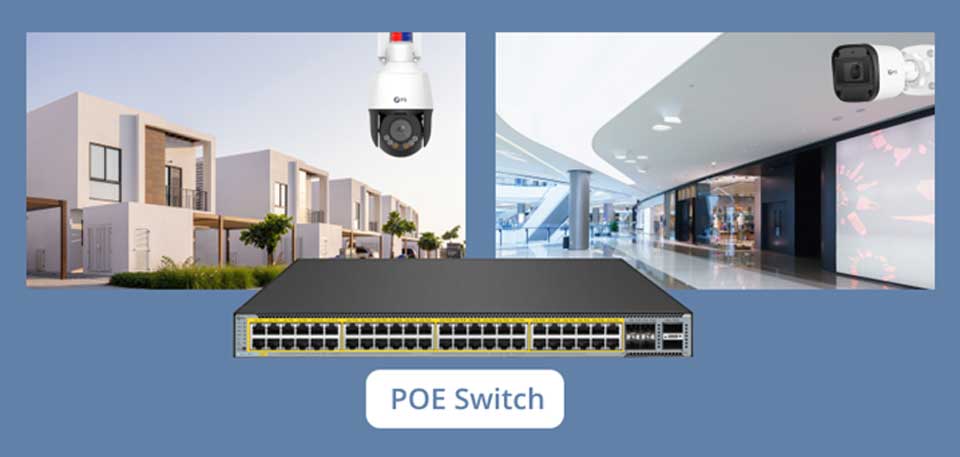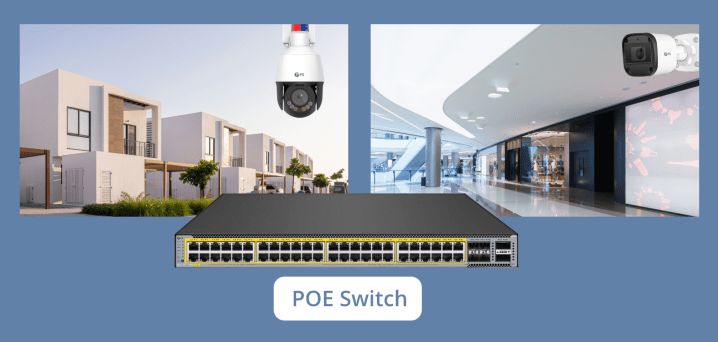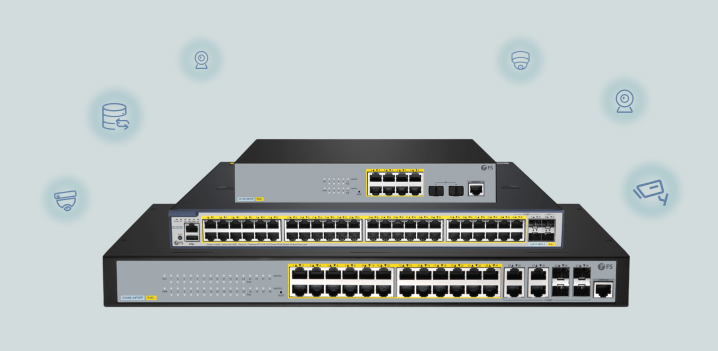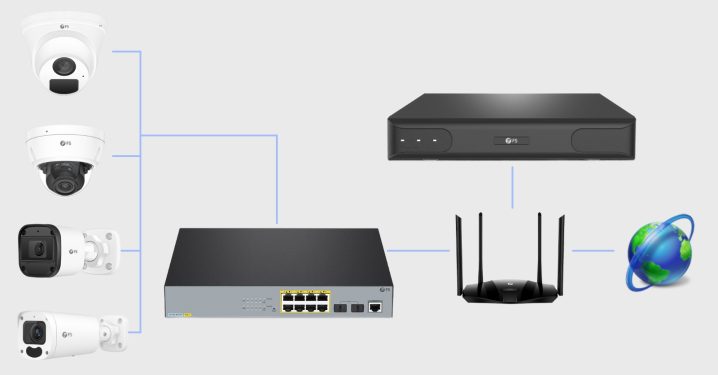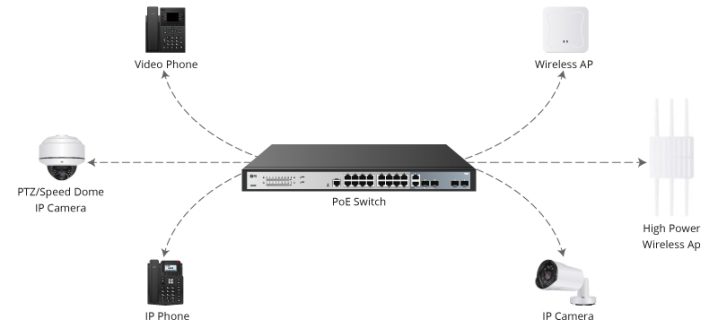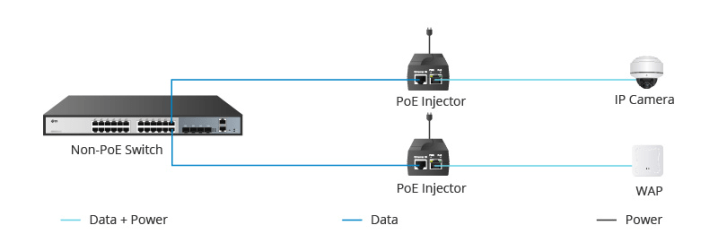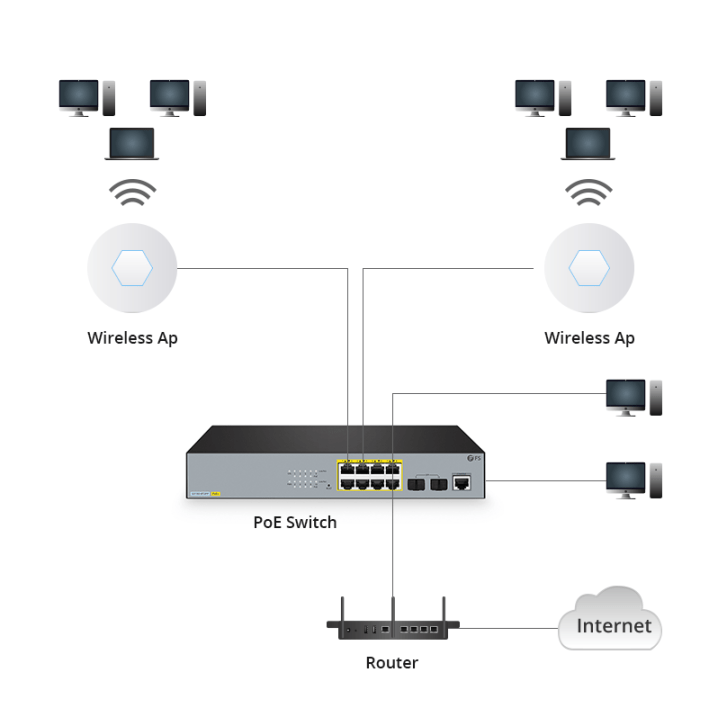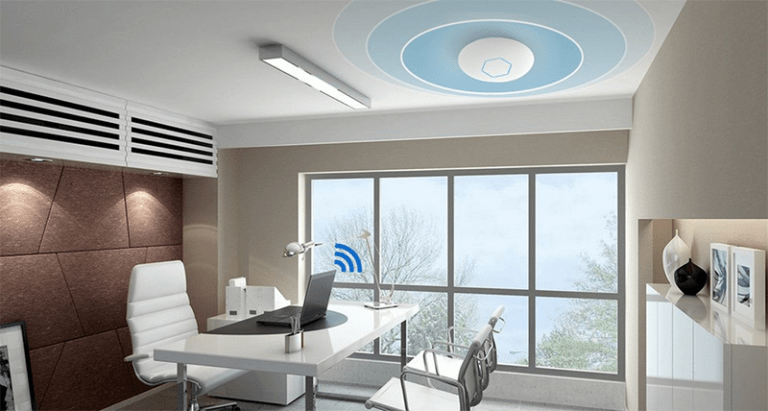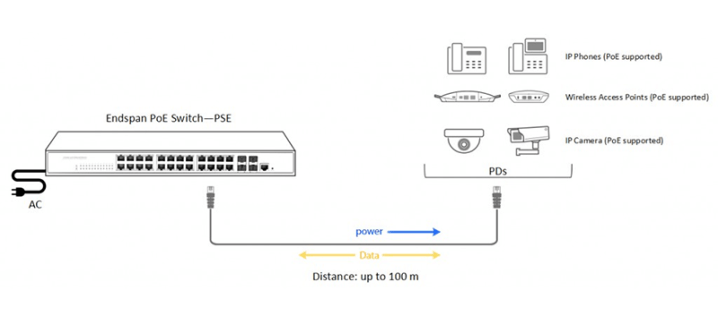How to Choose the Suitable PoE Switches for IP Camera Systems? To obtain visibility and insight into your business, IP cameras are a vital component of most business-related surveillance systems. At the same time, IP cameras are also widely used in various home scenarios for surveillance and security purposes. PoE switches for IP cameras are quite prevalent in today’s world.
They simplify cabling, provide power and data over a single Ethernet cable, and offer versatile solutions for both home and business surveillance. In this post, the article will explore the factors you should consider when selecting a PoE switch, provide some purchasing tips, and empower you to make an informed choice that suits your specific needs.
Why Use the PoE Switch for IP Camera Systems?
The key advantage of the PoE switch is its ability to transport both power and data over a single line, eliminating the need for an individual power supply for each camera or a traditional power box.
How to Choose The Suitable PoE Switch for IP Camera Systems?
To choose a suitable, reliable and best PoE switch for your IP security cameras, there are few factors you need to consider:
IP cameras not only require power but also a stable network connection provided by the PoE switch. Different switches offer varying bandwidth capacities. For instance, fast-Ethernet PoE switches typically provide between 10 to 100 Mbps, while gigabit PoE network switches offer 1 Gbps. Beyond that, the number of ports your PoE switch has and their power capabilities is a fundamental consideration. Calculate the number of IP cameras you intend to connect to the switch and assess their power requirements.
Ensure that the power supply voltage of the switch aligns with the voltage requirements of your IP cameras. Using the wrong power voltage can lead to camera malfunction, causing irreversible damage.
A PoE switch’s power budget is the maximum wattage that it can offer. The additional total wattage from connected devices should not approach or surpass the switch’s maximum power budget. When selecting a switch, examine the budget per port to ensure that it is adequate to power your IP cameras.
How to Choose the Suitable PoE Switches for IP Camera Systems?
The choice between managed and unmanaged PoE switches depends on your specific needs. Unmanaged switches are plug-and-play, requiring no configuration. These are suitable for home users and simple setups. Managed switches, on the other hand, offer advanced features like network optimization, remote control, and greater insight into network status. They are ideal for more extensive surveillance projects such as in enterprises or large facilities.
Tips for Selecting the Right PoE Switch for IP Camera Systems for Your Needs
To make an informed decision, consider the following tips:
How to Connect IP Cameras to a PoE Switch?
Connecting IP cameras to a PoE switch might sound complex, but it’s relatively straightforward. Here are the general steps involved:
Note: If you are looking for a PoE switch to be used in harsh environments such as traffic control cabinets, factory floors, and outdoor places where the temperature is extremely low or high, FS’s industrial PoE switches can be a good choice.
These switches comply with IEEE 802.3af/at PoE standards and can automatically detect and provide the required power for your PoE devices. Other than that, they can also withstand a high degree of vibration and shock while operating in harsh environments from -40° to 75°C, which makes them ideal for outdoor surveillance deployment.
Summary
Choosing the right PoE switch for IP camera systems is paramount for building an efficient and reliable IP camera system. By considering factors like port numbers, power supply voltage, power budget, maximal power supply, bandwidth capacity, and managed/unmanaged switch options, you can tailor your choice to your specific needs. We also provide unmanaged/managed PoE switches with 8-port,16-port, 24-port, 48-port, and industrial switches for different IP camera security systems.
PoE Switch vs PoE Injector: Why Choose PoE Switch to Build Wireless Networks?
Power over Ethernet (PoE) technology has revolutionized the way we build wireless networks by allowing data and power to be transmitted over the same Ethernet cable. By utilizing existing twisted-pair Ethernet infrastructure, PoE allows power devices (PDs) such as IP cameras and wireless access points to receive power without requiring any additional modifications to the infrastructure.
You can refer to resources such as the Demystifying PoE Network: Features, Standards, Types, and Common FAQs guide to get more detailed information. When it comes to implementing PoE technology, there are two main options: PoE switches and PoE injectors. In this article, we will explore the differences between these two options and explain why a PoE switch is often the better choice for building wireless networks.
What Is A PoE Switch?
A PoE switch is a network switch that has built-in PoE functionality, allowing it to provide power to connected devices directly through the Ethernet cable. This means that you can connect PoE-enabled devices such as IP cameras and wireless access points directly to the PoE switch using Ethernet cables, and the switch will automatically provide power to the devices without requiring any additional equipment.
What is A PoE Injector?
A PoE injector is a device that adds PoE functionality to non-PoE network switches or routers. You connect the injector between the non-PoE switch and the PoE-enabled device, and it injects power into the Ethernet cable to provide power to the device. This requires an additional step in the installation process, as you need to connect the injector to both the device and the non-PoE switch.
Build Wireless Networks: PoE Switch vs PoE Injector
While both PoE switches and PoE injectors can provide power over Ethernet cables, there are several reasons why a PoE switch is often the better choice for building wireless networks.
PoE Switches Are More Convenient and Easier to Install
PoE switches are more convenient and easier to install than PoE injectors. With a PoE switch, you do not need to use any additional equipment to provide power to your devices, which simplifies the installation process and reduces the number of cables needed. In contrast, a PoE injector requires an additional step in the installation process, which can be time-consuming and may require additional equipment.
PoE Switches Are More Cost-Effective
Considering the long-term perspective, PoE switches offer better cost-effectiveness. While the upfront cost of a PoE switch may be higher than that of a PoE injector. By eliminating the need for additional injectors, you save on the cost of purchasing and maintaining multiple devices. Simplified installation and centralized power management also contribute to cost savings in terms of time and effort.
PoE Switches Offer Greater Flexibility and Scalability
PoE switches offer greater flexibility and scalability than PoE injectors. With a PoE switch, you can connect multiple PoE-enabled devices to the same switch, which allows you to expand your network as needed. In contrast, a PoE injector can only provide power to a single device, which limits your ability to expand your network.
PoE Switches Are More Efficient for Building Wireless Networks
Building wireless networks via PoE switch is more efficient than PoE injectors. To build an enterprise PoE wireless network, the Power over Ethernet switch connects to a router that connects to the Internet. The network provides network connectivity among PoE wireless network devices and computers that have a wired connection to the switch. The PoE wireless access points connect to the PoE switch, providing them with power. Each wireless access point connects multiple wireless devices to the network.
The picture below shows a wireless network in an office. The wireless AP is installed on the ceiling. Cat5e or Cat6 network cable delivers data and power from the nearest PoE switch. Compared with the PoE injector, using a PoE Ethernet switch to power the AP is more efficient for the wireless network because you don’t need to worry about the power outlets. In addition, you don’t have to specifically buy a Cat5e or Cat6 Ethernet cable for power transmission.
PoE Switches Offer Better Management and Control Features
PoE switches offer better management and control features than PoE injectors. PoE switches are available to suit all applications from low-cost unmanaged edge switches with a few ports, up to complex multi-port rack-mounted units with sophisticated management. With a PoE switch, you can easily monitor and control the power usage of connected devices, which can help you optimize your network’s performance and reduce energy costs. In contrast, a PoE injector does not offer these management and control features.
PoE Gigabit switch certificated by IEEE 802.3af standard, sends power and data to PoE devices over a single cable, which requires no additional wiring, power sources, or adapters.
How to Choose a PoE Switch for a Wireless Network?
When planning to choose a PoE switch, we recommend that you should take the following three aspects into consideration.
For more detailed information about how to choose a PoE switch, you can click: PoE vs PoE+ vs PoE++ Switch: How to Choose? And the following video shows you how to connect the PoE switch.
Conclusion
In conclusion, while both PoE switches and PoE injectors can provide power over Ethernet cables, a PoE switch is often the better choice for building wireless networks. PoE switches are more convenient, easier to install, efficient, offer greater flexibility and scalability, and provide better management and control features than PoE injectors. By choosing a PoE switch, you can build a more efficient and effective wireless network that meets your needs and helps you achieve your goals. PoE switch and wireless AP are available in FS, where you can find a wide selection of PoE switches.
